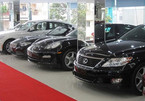According to MOIT’s Deputy Minister Tran Quoc Khanh, high-cylinder capacity cars (more than 2500 cc) will see tariffs gradually cut to zero percent after nine years.

Meanwhile, the tariff cut for less than 2500 cc cars will be implemented over 10 years, and the roadmap for car parts will be seven years.
Cars imported from Europe are mostly luxury models.
|
At present, cars from the EU bear a high tax rate of 70 percent. The selling price is 2-3 times higher than the original price because the cars bear many kinds of taxes and fees. |
The trade agreement includes an important provision that, five years after the agreement takes effect, Vietnam will accept the EU quality certificate, which means that the EU’s cars won’t need quality certificates to enter Vietnam. This means that Vietnam will create more favorable conditions for EU cars to penetrate the Vietnamese market.
However, analysts said they still cannot predict the attractiveness of European cars in the Vietnamese market. Most Vietnamese are familiar with popular brands such as Hyundai, Kia Morning and Toyota. The tariff cuts on European cars are not expected to have much effect on the home market.
At present, cars from the EU bear a high tax rate of 70 percent. The selling price is 2-3 times higher than the original price because the cars bear many kinds of taxes and fees.
According to Dang Dinh Dao from Hanoi Economics University, it is highly possible that the Ministry of Finance, under pressure because of the scanty budget, may think of solutions to raise domestic taxes and fees to offset the tax collection reduction to be caused by tariff cuts.
He also stressed that the government has shown clearly that it will create the most favorable conditions to develop the domestic automobile industry. This means that automobile joint ventures and Vietnamese owned manufacturers will continue receiving support to develop.
As such, not only imports from Europe, but also from the US and Japan, will meet barriers imposed by Vietnam to restrict imports into the Vietnamese market. And once Vietnam raises domestic taxes and fees, the price of luxury cars will not likely decrease.
As for CPTTP, 11 member countries will cut the import tariff to zero percent on industrial products, including cars.
However, car dealers said even after the tariff is cut, Vietnamese will not have good prices as expected.
Le Hoang Tung, the owner of a car salon in Tan Binh district, HCMC, said the tariff on ASEAN imports has been zero percent since January 1, 2018, but the prices of imports from the market have remained unchanged.
Mai Thanh

Vietnam’s automobile market to be flooded with zero-tariff ASEAN cars
The car sales in Vietnam are forecast to reach 500,000 units per year in 2020 and 1 million per year by 2030, with a turnover of US$12 billion each year.

Vietnamese Generation Z seeks career mentoring on social media
Social media platforms have outpaced other channels including schools, friends and traditional media to become the leading source for job finding.
 Asked about the import tariff on luxury cars from Europe after the EVFTA takes effect, the Ministry of Industry and Trade (MOIT) said the competitiveness of EU sourced cars would improve." itemprop="description" />
Asked about the import tariff on luxury cars from Europe after the EVFTA takes effect, the Ministry of Industry and Trade (MOIT) said the competitiveness of EU sourced cars would improve." itemprop="description" />